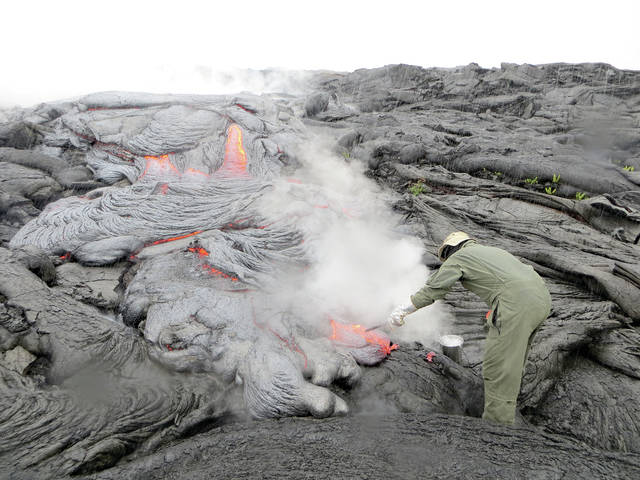Volcano Watch: Magma — what’s hot and what’s not

Scientists at the USGS Hawaiian Volcano Observatory routinely collect lava samples from Kilauea and use the chemistry of these samples to infer the temperature of magma (molten rock below Earth’s surface).
ADVERTISING
Through time, these measurements have shown magma temperatures rise and fall during an eruption, perhaps as the supply of magma to the volcano changes, or when the plumbing system is disrupted. Consequently, magma temperatures estimated from lava samples provide a fundamental means for tracking changing magma conditions and pathways within the volcano.
So, what’s the real scoop on magma temperatures? What temperature is deemed “hot” — and what’s not?
Magma rises from the mantle, a region deep within the Earth, into the “roots” of Kilauea at temperatures of about 1,500 degrees Celsius (2,700 degrees Fahrenheit). From there, the magma eventually makes its way to a primary storage chamber that’s about 3.5 km (2 mi) beneath the summit of Kilauea — a trip that takes about eight years, according to a recently published study on the volcano’s magma chemistry.
By the time magma reaches Kilauea’s summit storage chamber, it has cooled considerably. Samples collected from the lava lake within Halema‘uma‘u, which is a window into the summit storage chamber, indicate temperatures within the chamber are about 1,200 degrees C (2,200 degrees F).
If lava erupted at Kilauea is 1,200 degrees C (2,200 degrees F) or hotter, it is truly “hot.” This means the eruption likely tapped directly into Kilauea’s summit magma storage chamber or regions even deeper within the volcano.
Lower eruption temperatures can result from magma stalling, cooling and mixing as it moves out of the summit storage chamber and through the volcano’s shallow plumbing system.
For example, at the Pu‘u ‘O‘o eruption site, magma has been transported underground from Kilauea’s summit and through the East Rift Zone, a distance of about 19 km (12 mi). During this trip, it mixes with cooler magma stored in pockets along the rift.
The result is that lava samples collected at the Pu‘u ‘O‘o vent now indicate magma temperature of about 1,150 degrees C (2,100 degrees F), roughly 50 degrees C (about 100 degrees F) cooler than magma in the volcano’s summit storage chamber.
A drop from 1,200 to 1,150 degrees C (about 2,200 to 2,100 degrees F) might seem small. However, a significant amount of change to the magma occurs during that minor decrease in temperature. At 1,200 degrees C (2,200 degrees F), magma in the summit storage chamber has already cooled enough to crystallize a bit.
At that point, it’s a mixture of liquid magma and minor amounts of olivine and spinel, high-temperature mineral crystals. But, by the time the magma reaches Pu‘u ‘O‘o, it has cooled and crystallized even further, adding pyroxene and plagioclase, slightly lower temperature mineral crystals, to the mix.
But how cool can Kilauea magma get? As it turns out, it can’t cool too much before it solidifies, which occurs at a temperature of about 1,000 degrees C (about 1,830 degrees F). Of course, at this temperature the magma would still be glowing hot. But since it’s no longer a liquid, it can’t flow as one.
So, within Kilauea, magma can have temperatures from about 1,200 degrees C (2,200 degrees F) down to about 1,000 degrees C (about 1,830 degrees F). The former temperature is indicative of molten rock within the summit storage chamber, and the latter temperature suggests solidified but still very hot rock.
On Kilauea Volcano’s East Rift Zone, where magma is being steadily transported underground from the summit to Pu‘u ‘O‘o, temperatures hover at about 1,150 degrees C (2,100 degrees F).
Exactly how we infer magma temperatures from the chemistry of lava samples collected at Kilauea will have to be the topic of another Volcano Watch. But the short explanation is that we use experimentally calibrated equations that model chemistry changes during cooling and crystallization. These are called geothermometers.
So, whether magma is hot, or not so hot, measuring its temperature through lava samples provides a window into the inner workings of a volcano.
Volcano activity updates
This past week, Kilauea Volcano’s summit lava lake level fluctuated with summit inflation and deflation, ranging about 28-34 m (92-112 ft) below the vent rim.
On the East Rift Zone, the 61g flow remained active, with lava reaching the Kamokuna delta and surface breakouts downslope of Pu‘u ‘O‘o.
The 61g flows do not pose an immediate threat to nearby communities.
Mauna Loa is not erupting. Small-magnitude earthquakes occurred beneath the summit caldera and upper Southwest Rift Zone, mostly at depths less than 5 km (3 mi).
GPS and satellite radar measurements continue to show deformation related to inflation of a magma reservoir beneath the summit caldera and upper Southwest Rift Zone.
No significant changes in volcanic gas emissions were measured.
No earthquakes were reported felt on the Island of Hawaii during the past week.
Visit the HVO website (https://volcanoes.usgs.gov/hvo) for past Volcano Watch articles, volcano updates and photos, recent earthquake info, and more. Call for summary updates at 808-967-8862 (Kilauea) or 808-967-8866 (Mauna Loa). Email questions to askHVO@usgs.gov.
Volcano Watch (https://volcanoes.usgs.gov/hvo/hvo_volcano_watch.html) is a weekly article and activity update written by U.S. Geological Survey Hawaiian Volcano Observatory scientists.


